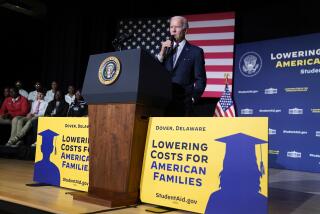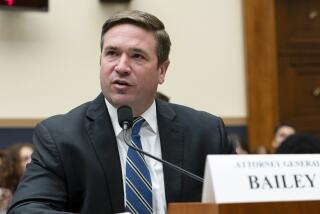Cast a Wide Net to Pay for College
For Matt Morris, the good news and the bad news came in the same envelope -- his acceptance letter from the University of Southern California’s film school.
It is, after all, one of the most lauded programs in the country. But at $44,000 a year, it’s also one of the most costly, and his financial aid grant was nowhere near enough to make it affordable.
Now the big issue for Morris is how to pay the tab at a time when federal grant money is scarce, competition for academic scholarships is intense and interest rates for student loans are rising.
Paying for college is particularly thorny for middle-income families because higher-income parents can better afford it and lower-income students can get much more financial aid.
Complicating matters further are housing values, which have soared in recent years, boosting home equity for many middle-income parents. This paper wealth puts them in a bind when their children choose private schools, which can count home equity as an asset the parents can tap to pay for college.
But tapping that equity forces parents to pay on bigger home mortgages as they use most of their disposable income to pay college bills.
“It has gotten progressively tougher to finance college every year,” said David Jaffe, president of College Pursuit, a New York-based college consulting firm. “Parents are in a really tough spot. I see them giving up home equity. I see them giving up their retirement money.”
As students like Morris can attest, financial aid for middle-income families is increasingly about loans, loans and more loans. But experts say there are ways to cut the number of loans needed and make wiser choices among the lending options.
It all starts with a financial aid award letter-- which all students who have applied for aid should receive from any college that accepted them. These award letters detail the scholarships, grants and loans available to the student from federal, state and school-based aid programs.
This is the cornerstone of college finance, but it’s not the last word, said Martha Holler, a spokeswoman for student lender Sallie Mae.
Chances are, the award letter will provide a handful of sources of free money -- scholarships and grants based on need and merit -- and a list of loans and work-study awards.
Morris, for example, said he had received about $6,500 in scholarships, “enough to take the edge off” but not nearly enough to finance the entire bill. USC expects him to come up with the rest of the tab by working, using his parents’ resources and taking out loans.
Before Morris heads down those roads, Holler suggested that he seek out private scholarships. Although it is too late to apply for some of these grants, others have late deadlines. The rules affecting private donor awards are as diverse as the individuals and organizations that provide them. These groups include corporations aiming to encourage certain fields of study, service groups such as the Knights of Columbus or DeMolay International, and even private individuals.
The easiest way to find private scholarships is to search on the Web. At sites such as www.fastweb.com, www.CollegeAnswers.com and www.finaid.com, applicants fill out detailed surveys about their family history, awards and interests. The sites then search for relevant scholarships, sending links and applications to the student.
Students are well advised to apply for everything that has an even modest chance of success -- even if they’re small amounts. But this aid will affect the aid the college provides, said Joe Russo, director of student financial strategy at the University of Notre Dame in Indiana. Notre Dame tells its students that they must inform the college when they receive scholarships not listed on their aid award letters. Those scholarships will reduce other aid, he added, but will generally offset loans rather than grants.
Once all sources of free money are exhausted, students and parents have myriad loans to choose from:
* The best of the lot, for those who qualify, Russo said, is the Perkins Loan -- federally subsidized loans for students with demonstrated financial need. The government pays the 5% fixed interest rate while the student is in school and through a nine-month grace period after graduation.
There are no origination or guarantee fees, but the maximum loan amount for undergraduate students is $4,000 -- and few students qualify for the full amount.
* The next-best option is Stafford loans, which come in two forms -- subsidized and unsubsidized. Starting in July, the interest rate on all newly issued Stafford loans will be fixed at 6.8%. For a subsidized Stafford loan, the government pays the interest while the student is in school. But more commonly, middle-income students are offered unsubsidized loans, for which the interest accumulates while the student is in school. Therefore, the loan amount -- the maximum is $2,625 in 2006 -- will grow until the student begins to pay it off.
The big trick with Stafford loans is realizing that the origination and guarantee fees that are charged up front are negotiable. Many lenders waive most, if not all, of these fees, which can add up to as much as 4% of the loan amount. Pending changes will alter the fees charged in 2007. For now, students need to know that every lender will charge the same rate on a Stafford loan, but it’s worth shopping for lenders who will waive the fees.
Those who reach their Perkins and Stafford borrowing limits and still need more aid have four additional options -- monthly payment plans; parent loans; home equity loans; and private loans:
* Monthly payment plans are simply an arrangement with the school -- or a third-party financial service -- to break the remaining cost of tuition (after scholarships and other loans) into nine or 10 monthly payments. For families that don’t have the cash flow to handle the bill in one fell swoop, these are a terrific option. Typically, the only cost is a sign-up fee of $40 or $50, depending on the school.
* Parent loans fall under the federal student loan program. As such, they have set rates and fees. As of July 1, all parent loans, dubbed PLUS for Parent Loan for Undergraduate Students, will be at a fixed 8.5% rate for the life of the loan. These loans are also subject to 4% origination fees, and, unlike student loans, parents must start repaying this debt within 60 days after the funds are disbursed. They are generally repaid over 10 years.
With those rates and fees, PLUS loans aren’t a huge bargain. But if the parents have a poor credit rating, they may be worth applying for because these parents have fewer low-cost borrowing options and, if they’re turned down for a PLUS loan because of credit problems, their children may be able to borrow more under the lower-cost Stafford loan program.
* Home equity lines of credit may be a better option for some parents. A good credit risk can often secure a home equity line at prime rate -- currently 7.75% -- or just a fraction more. However, these loans are generally variable rate, which means they could become more costly if the Federal Reserve continues to hike interest rates.
On the plus side, interest paid on home equity debt of as much as $100,000 is tax deductible -- no matter what the money is used for -- which lowers the after-tax cost.
The downside to home equity debt is that these loans put the house on the line, giving the lender the right to foreclose on the property if the loan is not repaid. If there’s any chance the parents will have trouble repaying, they’d be well-advised to stick with unsecured loans, even if they cost a little more.
* Private and alternative student loans have cropped up in large numbers as lenders have discovered that the federally guaranteed options are increasingly insufficient to deal with the rising cost of college. The terms and conditions of these loans, however, vary widely. Some can be as attractive as PLUS loans, whereas others are far more costly and less flexible.
These bank loans are usually variable rate and can be taken out by the student or the parents. The loan rate will vary based on the lender and the borrower’s credit profile. Holler suggests that students consider getting a cosigner if they take out the loan because it’s likely to win them a considerably lower rate.
In any event, she said, the private loan is probably the last option, to be used when the student’s ability to borrow elsewhere is exhausted.
*
Kathy M. Kristof, author of “Investing 101” and “Taming the Tuition Tiger,” welcomes your comments and suggestions but regrets that she cannot respond individually to letters or phone calls. Write to Personal Finance, Business Section, Los Angeles Times, 202 W. 1st St., Los Angeles, CA 90012, or e-mail kathy.kristof@latimes.com. For previous columns, visit latimes.com/kristof.
More to Read
Sign up for Essential California
The most important California stories and recommendations in your inbox every morning.
You may occasionally receive promotional content from the Los Angeles Times.










